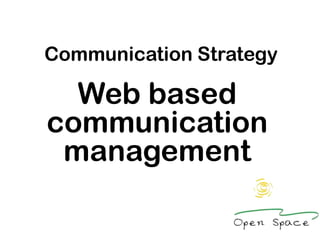Communication strategy (web)
- 1. Communication Strategy Web based communication management
- 2. The principles ŌĆó Same strategic communication principles ŌĆó WH still matters ŌĆó Communication is active: engage ŌĆō Go to your audience ŌĆō Get them to come to you ŌĆó Keep the ecosystem in mind ŌĆó Multi-screen consumption ŌĆó Engage off-line ŌĆó Build a critical mass
- 3. The doŌĆÖs ŌĆó Highlight the issue rather than your organisation ŌĆó Update daily (regular, systematic, incremental) ŌĆó Ask for specific help ŌĆó Show the specific impact (request hand pump, show picture of the working hand pump) ŌĆó Have light images for easy rendering ŌĆó Make it easy for people to use your website ŌĆō Get information ŌĆō Give comments (engage) ŌĆō donate
- 4. The donŌĆÖts ŌĆó Overwhelm with design (text, colours) ŌĆó Complicated pictures/graphs (complicated for your intended readers) ŌĆó Website should not be a webpage/static ŌĆó Copyright ŌĆó Flame/spam ŌĆó Trust any web profile ŌĆó Relax on security
- 5. WH before... ŌĆó Why are you having a website? ŌĆó Who is your target audience? ŌĆó Where will they access your content? ŌĆó What do you want them to do? ŌĆó Why is your website the preferred destination? (TINA) ŌĆó How are you going to keep them there?
- 6. TA ŌĆó What is the penetration of web in the TA? ŌĆó Broadband (Ōēź 256 Kbps) 14.5 million (12%) ŌĆó 4Mbps 8% (112) (90% in UK) ŌĆó Average internet speed 885Kbps; UK 4909 Users ŌĆó Computer literates 224m ŌĆó Users 150m (122 active) ŌĆó Urban 84m; Rural 38m ŌĆó Local language 45m ŌĆō Urban 20.9m (25%) ŌĆō Rural 24.3m (64%) ŌĆó Search for government schemes
- 7. TA Telephones (including mobiles) ŌĆó Overall coverage (79.58%) ŌĆó Urban (169.03%) ŌĆó Rural (40.66%) Mobiles ŌĆó 934.09 million in June 2012. ŌĆó 597.59 m (urban) 336.51m (rural). ŌĆó 695.82 million (74.49%) active. Teledensity ŌĆó Over 90%. Haryana, Gujarat, Maharashtra, and Karnataka ŌĆó Over 100% Kerala, Punjab, Himachal, and Tamilnadu ŌĆó Delhi has 238.6% ŌĆó Mobile : urban (63.98%) rural (36.02%)
- 8. TA Television ŌĆó Number of TV homes in India 148 million (2011). ŌĆó Cable 94m (88m analog; 6m digital) ŌĆó DTH 41m Newspapers 329,204,841 cgnet: 080-41137280 (1=record; 2=listen)
- 9. Ecosystem ŌĆó Multimedia/multi screen ŌĆó SMS ŌĆó Email / egroups / footers / subjectlines ŌĆó Facebook / Linked in / Twitter (#hashtag) / ║▌║▌▀Żshare (tags) /youtube (chanel) ŌĆó Blogs ŌĆó Rich Site Summary/Really simple syndication (RSS) ŌĆó Post / comment on otherŌĆÖs blogs ŌĆó Carpet bomb, but not spam (shrills)
- 10. KISS MII: minimalist messaging
- 11. Distribution models ŌĆó Library (not book depot!) ŌĆó Town hall ŌĆó Debating club ŌĆó Market ŌĆó Mass consumption? ŌĆó Targeted distribution? Lists and teasers ŌĆó Peer groups? Link exchange/tags ŌĆó Engage, encourage
- 12. Advantages ŌĆó First mover (still creating theory) ŌĆó 24x7 ŌĆó Global outreach and access ŌĆó Dynamic (links, change/edit/update... At virtually no cost) ŌĆó Data and information out there (need to aggregate into actionable knowledge)
Editor's Notes
- #11: http://theenlivenproject.com/the-truth-about-false-accusation/http://blog.bennettandbennett.com/2013/01/lies-damn-lies-and-infographics.html











